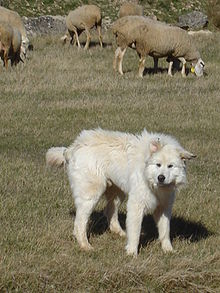Pyrenean Mountain Dog
| Pyrenean Mountain Dog | |||||||||
|---|---|---|---|---|---|---|---|---|---|
 | |||||||||
| Other names | Great Pyrenees Chien des Pyrénées Chien de Montagne des Pyrénées Montañés del Pirineo | ||||||||
| Origin | France/Spain[1] | ||||||||
| |||||||||
| Dog (domestic dog) | |||||||||
The Pyrenean Mountain Dog, known as the Great Pyrenees in the United States, is a large breed of dog, used as a livestock guardian dog.
The Great Pyrenees is a very old breed, and has been used for millennia by the shepherds which includes Basque people, who inhabit parts of the region in and around the Pyrenees Mountains of southern France and northern Spain.[2] More recently, the breed served as the official dog of the royal French court (whose prominence began circa the Middle Ages, and lasted until the middle of the nineteenth century). During World War II the dogs were used to haul artillery over the Pyrenean Mountain range to and from Spain and France. They are related to several other large white European livestock guardian dogs (LGD), including the Italian Maremma Sheepdog, Kuvasz (Hungary), Akbash Dog (Turkey) and Polish Tatra or Polski Owczarek Podhalański.
Description
Males grow to between 110-120 pounds (50-55kg) and 27-32 inches (69-81cm), while females reach between 80-90 pounds (35-40kg) and 25-29 inches (64-74cm). They will live to between 10-12 years of age. Their coats are white and can have varying shades of gray, Red (rust) or tan around the face (including a full face mask), ears and sometimes on the body and tail; as a Great Pyrenees matures, their coats grow thicker and the longer colored hair of the coat often fades on those dogs that were not born completely white. Sometimes a little light tan or lemon will appear later in life around the ears and face. Being a double coated breed, the undercoat can also have color and the skin as well. The color of the nose and on the eye rims should be jet black. [3] Grey or tan markings that remain lend the French name, "blaireau," (badger) which is a similar grizzled mixture color seen in the European Badger. More recently any color is correctly termed "Badger" or "Blaireau." [4]All white dogs are not preferred by top breeders for many reasons. Therefore, these all white dogs in most breedings are less frequent. It's not unusual that breedings that result in a high incidence of all white puppies do not have the required jet black pigment on the nose and eye rims. These breeding lines are therefore not, as a rule, desirable in well bred stock. There are generally all white puppies in most litters. This is normal and these all white puppies can be bred successfully in the hands of a competant breeder. The rear leg bilateral double dewclaws are required.
In popular culture

This article may contain minor, trivial or unrelated fictional references. (May 2008) |
- In the anime/manga Azumanga Daioh, Chiyo Mihama's pet Tadakichi-san (Mr. Tadakichi) is a Great Pyrenees.
- In the novel, Belle et Sébastien and 60s children's TV series, Belle is a Great Pyrenees.
- The 2004 film Finding Neverland used a Great Pyrenees to represent J.M. Barrie's Landseer Newfoundland.
- The Spanish designer Javier Mariscal was inspired by this dog breed for the design of the 1992 Summer Olympics mascot "Cobi".
- In Hanazakarino Kimitachihe, the male lead had a Great Pyrenees named Yu Ci Lan for a pet.
- The Japanese series Ginga Densetsu Weed features a Great Pyrenees named Hiro.
- In the film "Those Magnificent Men in their Flying Machines" (1965) a Great Pyrenees is the household dog at the Lord Rawnsley estate.
- In the Marx Brothers' "Horse Feathers" there's a Great Pyrenees in the dog catcher's wagon.
- In the Korean variety show Happy Sunday - 1 Night 2 Days, Sang Geun is a Great Pyrenees.

See also
References
- ^ http://www.greatpyrenees.com/ A profile on the history of the breed
- ^ http://clubs.akc.org/gpca/gpcabreed.html Early History of the breed
- ^ http://www.akc.org/breeds/great_pyrenees/index.cfm American Kennel Club Profile
- ^ http://clubs.akc.org/gpca/gpcabreed.html A description of the breed
External links
- Great Pyrenees Community The gathering place for everyone who has an interest in Great Pyrenees. Study groups, blogs, and much more with levels of interest for everyone.
- Great Pyrenees Library : interesting and useful articles on breeding, behavior, livestock guardians, Great Pyrenees rescue and medical information
- GreatPyr.com : Great Pyrenees Information & Resources. Photo Gallery, Forums, and Breed Information
- Great Pyrenees Connection: Great Pyrenees breed information, photographs, history of the breed in France and the Netherlands, links to international Great Pyrenees breeders and Great Pyrenees clubs
- Great Pyrenees Dogs: Info about the breed as a family pet
- Movie about the characteristics of the Pyrenean Mountain Dog
